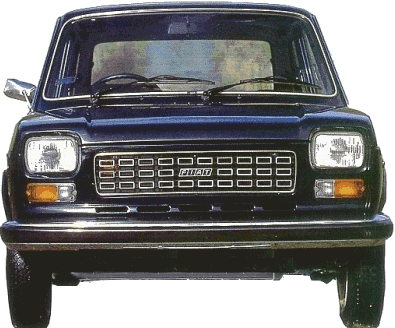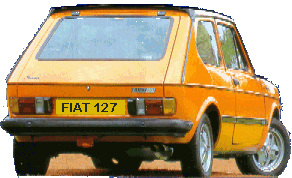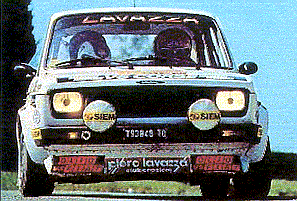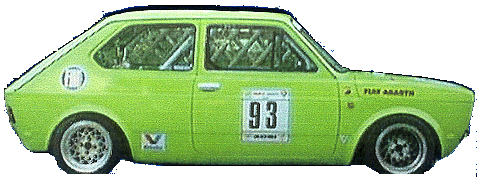By Rob Miller
 So you fancy a 127, Fiat put a lot of work into the development of the 127 and when introduced in 1971, it was one of the first cars built to conform with the latest European safety regulations. These included what is now taken for granted in vehicle design, progressive body deformation under impact, crumple zones. Indeed, even the floor was strengthened to resist side impact. It was voted car of the year in its first year of production. Fiat’s policy of numbering their models in line of production meant that the 127 filled the gap between the 126 and the 128.
So you fancy a 127, Fiat put a lot of work into the development of the 127 and when introduced in 1971, it was one of the first cars built to conform with the latest European safety regulations. These included what is now taken for granted in vehicle design, progressive body deformation under impact, crumple zones. Indeed, even the floor was strengthened to resist side impact. It was voted car of the year in its first year of production. Fiat’s policy of numbering their models in line of production meant that the 127 filled the gap between the 126 and the 128.
 With the 500’s appeal all over the world along with Fiat’s best selling 600 and 850 range of vehicles, the 127 was to be influenced in design, by all of these but would incorporate the front wheel drive design of the 128. The 127 would be quicker through the gears and have a greater maximum speed than its forebears. The relatively new hatchback design, gave the car a roomy feel with an almost estate car like capacity with the rear seat folded. 127’s have fantastic maneuverability and an economy that can match many modern day small cars. But they have the Fiat built in character and drivability, which make them so much more worthwhile to own and enjoy.
With the 500’s appeal all over the world along with Fiat’s best selling 600 and 850 range of vehicles, the 127 was to be influenced in design, by all of these but would incorporate the front wheel drive design of the 128. The 127 would be quicker through the gears and have a greater maximum speed than its forebears. The relatively new hatchback design, gave the car a roomy feel with an almost estate car like capacity with the rear seat folded. 127’s have fantastic maneuverability and an economy that can match many modern day small cars. But they have the Fiat built in character and drivability, which make them so much more worthwhile to own and enjoy.
All series one cars had the 903cc OHV engine with four-speed transmission, this unit stayed with the 127 until its demise in 1983. In 1978 a new 1050cc OHC engine was introduced along with some body and interior changes marking the series two. The final 127s, the series three versions, had the option of a 1301cc OHC unit. Series three cars had the major improvement of a five-speed transmission option. Aficionados will also be aware that the series three cars had much more outer plastic trim attachments.
 The 127 came with many levels of trim; series one cars top spec was the special. Top spec for series two cars was the Palio; this was the only 127 produced with what is accepted nowadays as the norm, alloy wheels. Indeed this model is considered to be the prettiest of all the 127 cars and the “Palio” wheels as the alloys became known, were to be sought after add ons for many other Fiat marques right up to the present day. Series two 127’s had a Sport version introduced which had an up rated 70BHP version of the 1050 engine. Interiors had some nice high back seats, and the dashboard housed rev counter, oil and clock gauges. Spoilers were fixed front and rear. Final specs for the series three included the 1300GT, which had more power through a 75BHP engine. These later cars carried much more plastic outer trim with large square headlamps and a totally revised dashboard layout. In 1983 Fiat replaced the 127 ranges with the Uno.
The 127 came with many levels of trim; series one cars top spec was the special. Top spec for series two cars was the Palio; this was the only 127 produced with what is accepted nowadays as the norm, alloy wheels. Indeed this model is considered to be the prettiest of all the 127 cars and the “Palio” wheels as the alloys became known, were to be sought after add ons for many other Fiat marques right up to the present day. Series two 127’s had a Sport version introduced which had an up rated 70BHP version of the 1050 engine. Interiors had some nice high back seats, and the dashboard housed rev counter, oil and clock gauges. Spoilers were fixed front and rear. Final specs for the series three included the 1300GT, which had more power through a 75BHP engine. These later cars carried much more plastic outer trim with large square headlamps and a totally revised dashboard layout. In 1983 Fiat replaced the 127 ranges with the Uno.
Some 3.8 million Fiat 127s were built and sold in the production run of 12 years, Seat of Spain sold almost another million, this little vehicle was a success story right from the start. It can be compared with the sales story of the modern day Punto. People liked it; it did what the Fiat engineers designed it to do. And it did it well, the 127 was an attractive car, it was the right price, and it offered the prospective buyer a package of transportation in many cases superior to the competition of the day.
So what would the prospective 127 buyers have paid? In 1980 the “on the road prices” would have been thus:
- 127 900L £2994
- 127 1050L £3194
- 127 1050CL £3407
- 127 SPORT £3765
- 127 PALIO £3794
In the sales brochures of the day Fiat made much of door mirrors, heated rear windows, side rubbing strips, cigarette lighters, locking petrol filler caps, full carpeting and what I feel is sorely missed on modern cars, the opening front quarter light. That’s not to say that the 127 was not fully equipped, indeed it was, and had much more on offer than many of its competitors including, RWW, intermittent wipers, halogen lights, tinted windows, and much more.
ARE THEY A PRACTICAL CLASSIC?
Yes, and except for the 903 engine will run on unleaded if the ignition is retarded 4 or 5 degrees, the 127 will not be embarrassed in modern traffic and the l300GT in good fettle will annoy many owners of modern hot hatches. The 1050 Sport is a fast nippy little flyer but due to the nature of the beast, it can be a little frenetic approaching 5000 plus rpm at the legal limit, but will go all the way to around 100mph! Economic to run and cheap to insure, service items are readily available. Timing belt and oil change is imperative. Watch CV boot and drive-shaft rubber boots especially the latter they act also as an oil seal.
 So the 127 are well worth saving, their values can only increase. This forgotten classic is rising from the ashes of oblivion like the beautiful Phoenix that it is. Watch this space!
So the 127 are well worth saving, their values can only increase. This forgotten classic is rising from the ashes of oblivion like the beautiful Phoenix that it is. Watch this space!
PRICES: Really rotten examples can be bought for next to nothing, but nice examples can go for upwards of £700. The 1050 Sport and 1300GT models are the sought after versions, but they are now getting extremely rare. Again, grotesque cars can be got for peanuts, but the beautifully kept pristine versions will now command £2000 plus. I know of two 1300GT’s which have changed ownership for £1000 each just recently. These cars, whilst extremely sound and presentable, were by no means pristine show cars. A 1050 Sport with less than 13k miles was sold in showroom condition for £2500 almost two years ago……
BODY AND CHASSIS: If neglected the 127 will disintegrate almost while you watch it, but the thing is, you won’t see it till it’s at an advanced stage. Look everywhere but especially lower front screen surround near the corners, rear damper mounting area and rear inner wheel tub seam, floor, sills, and inner front wings. The rear tailgate can oxidise quite badly starting just under the base of the rear-screen rubber. It then spreads rapidly as water ingresses to the inside and if neglected, will start to erode the boot floor particularly in each corner. Door
bottoms can be bad if neglected. Fiat rust proofing was a hit and miss affair which means that on some examples panels will be rot free, but on others, to need repair or replacement. Most body panels can still be obtained either genuine or pattern or second hand, but it is felt that this situation may get patchy as time goes on. Some exterior trim is now difficult i.e. Spoilers bumpers and rubbing strips. You could theoretically rebuild a sad case but costs would outweigh final evaluation.
ENGINE: The 903cc unit has good longevity if cared for, it is renowned for its ability to rev, but can sound like a “bag of nails” if worked hard and abused. On the other hand, the sweet little ohc units are bullet proof if serviced and loved on a regular basis. Both present little hassle for the home mechanic. All year antifreeze protection with rust inhibitors is essential. Watch for oil leaks on cam cover and rotting bottom engine water outlet. Spares availability is very good though genuine pistons for the 1300 engine are drying up.
TRANSMISSION AND RUNNING GEAR: Four-speed box is thought to be much more forgiving than the later 5-speed and is a tough hardwearing unit. 5 speed gearboxes can develop weak synchros and have been known to begin jumping out of gear. Check the nylon bush in the selector lever and check for secure gear linkage connections if a rough or difficult change is experienced. On models fitted with the OHC engine, the nearside gearbox mounting has three bolts which screw into the gearbox casing, these have been known to work loose and in some cases fall off. Should a rebuild be required, parts are getting scarce but you can still obtain units second hand.
INTERIOR: Second hand is the only option, you may get lucky at an auto jumble if they also stock hens teeth.
 CONCLUSION: Definitely a classic bargain, but many will have received bodged-welding repairs over the years and interiors may be looking shabby. Buy the best you can find body wise and ensure the rest is complete and original. You will be rewarded with an economical, reliable, fun, little car, and if you can find a series two Sport, or later 1300GT, the traffic light grand prix will be a whole new ball game to the shock horror of the Nova boys!
CONCLUSION: Definitely a classic bargain, but many will have received bodged-welding repairs over the years and interiors may be looking shabby. Buy the best you can find body wise and ensure the rest is complete and original. You will be rewarded with an economical, reliable, fun, little car, and if you can find a series two Sport, or later 1300GT, the traffic light grand prix will be a whole new ball game to the shock horror of the Nova boys!

![Fiat Motor Club [GB]](http://fiatmotorclubgb1.netfirms.com/wp-content/uploads/2017/11/Website-Header-v3.jpg)